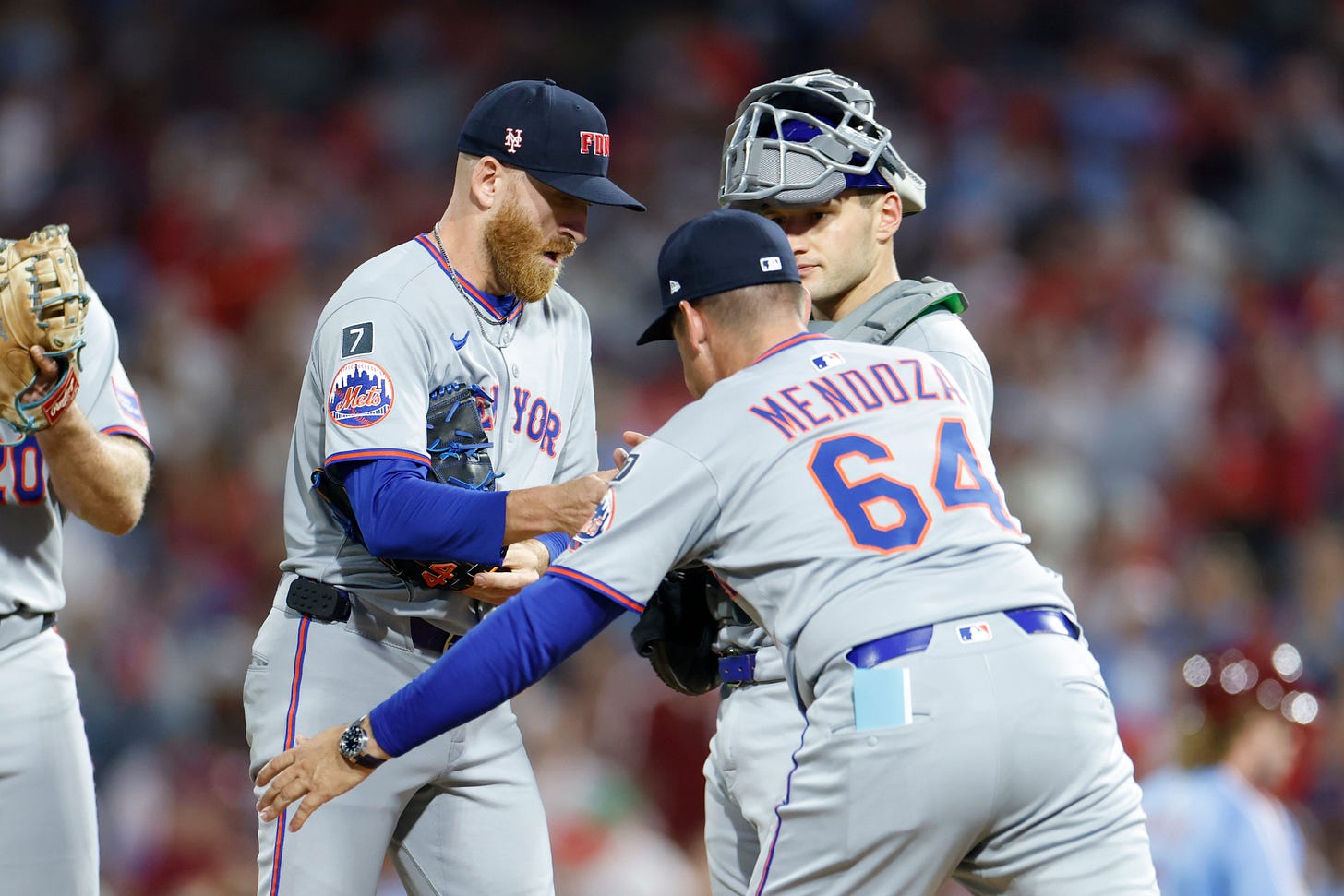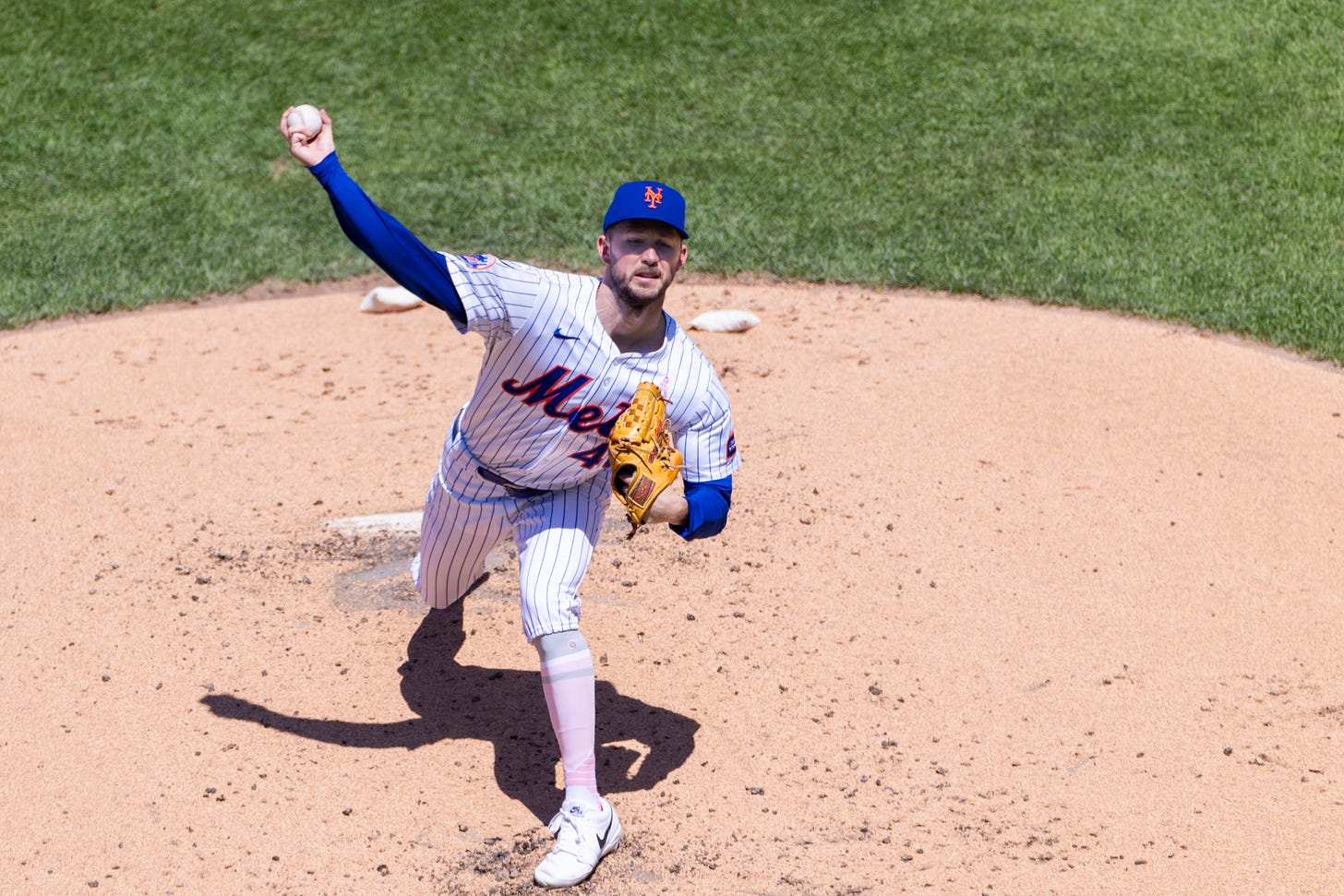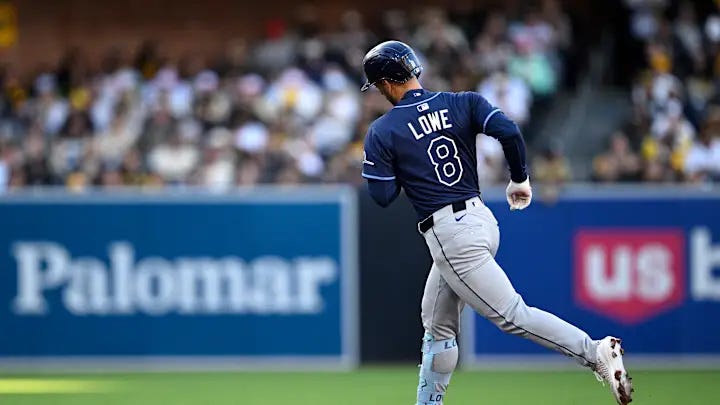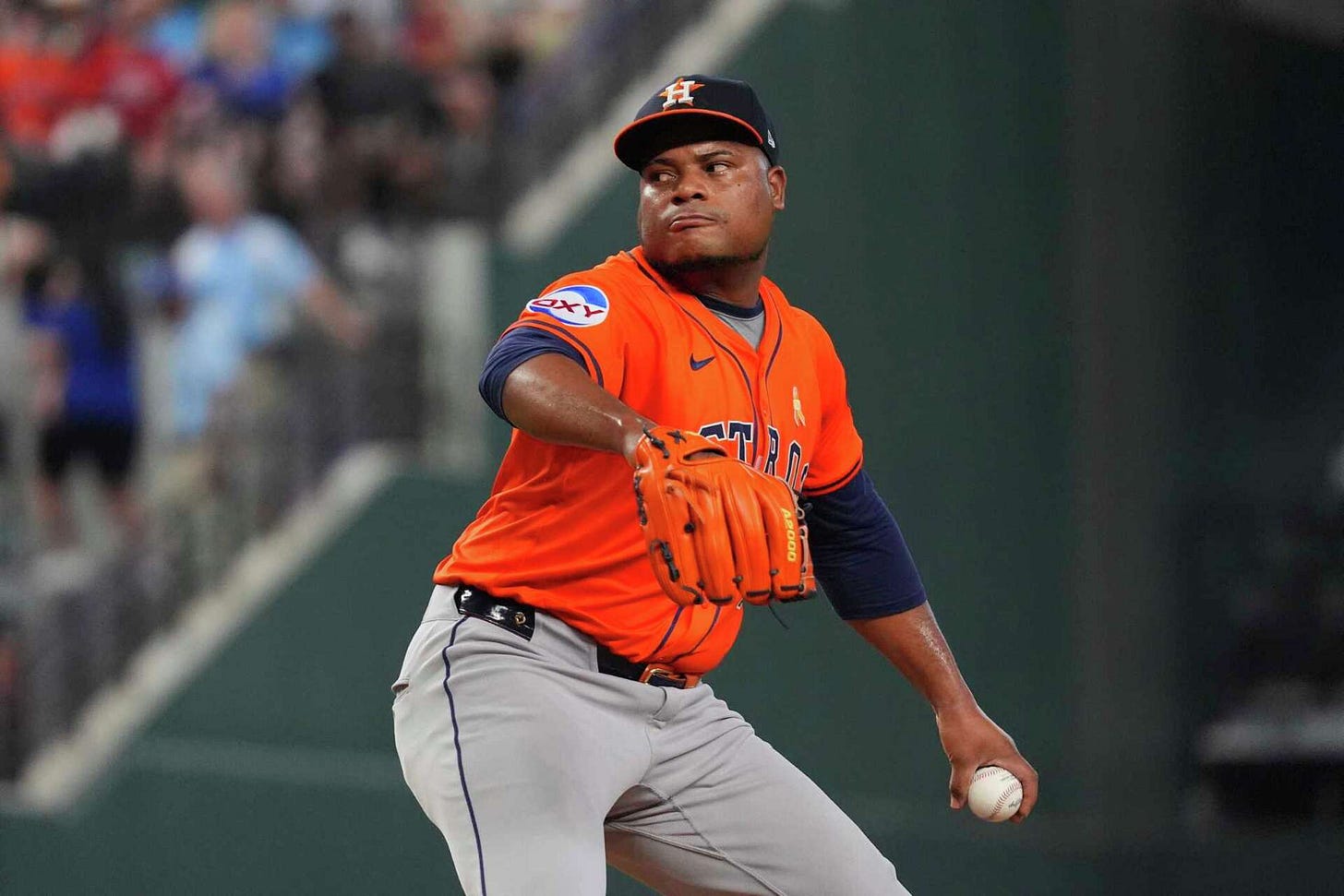If the Mets are to fix their pitching, they need to fix something else too
The Mets pitched terribly over their final 93 games, but their defense made matters worse for them
One of the obvious reasons why the Mets flopped, collapsed, and failed to make it to the postseason in 2025 was their pitching staff. There’s no debate or question that this is the primary area of emphasis heading into the winter, the part of the team Mets President of Baseball Operations David Stearns must fix in a major way over the next four months.
The line of demarcation for the 2025 Mets will always be June 13. That was the day it all changed. It changed for the pitching, and it changed for the defense. It was the last day Kodai Senga pitched in what was a brilliant run of starting pitching for the Mets, during which the rotation had posted an MLB-best 2.78 ERA over the season’s first 70 games. It was on that day Pete Alonso threw a ball high to Senga at first base on what was an ordinary pitcher’s fielding practice (PFP) play, something both he, Senga, and the entire pitching staff worked on in day one of spring training way back in February.
From that point forward, the rotation pitched to a 5.27 ERA, the fourth-worst in all of baseball, better than only the Angels, Nationals, and Rockies in that order. The 428.2 IP from the starters was the fewest in the game during that stretch, the 3.78 walks per nine innings were the most, the .314 average on balls in play was fourth-worst, their 4.31 fielders independent ERA (FIP) was the ninth worst, and so on and so forth.
But there’s one number that stands out to me specifically in that pitching disaster class, and that is the ground ball rate from their starting pitchers. Since June 13, Mets starters produced a 49 percent ground ball rate, which is the highest by 2.3 percent over the Phillies, who were second with a 46.7 percent ground ball rate during the same stretch.
Now, let’s correlate that ground ball rate with the defensive metrics of the Mets infielders, shall we?
Overall, the Mets had -13 outs above average (OAA), the ninth-worst mark in baseball. That’s not just since June 13; that’s the entire season. They did have 22 defensive runs saved (DRS), which was 15th, and committed only 79 errors overall, which was the seventh fewest in the game, believe it or not (it’s hard to believe considering how sloppy they were over the last couple of months, but that’s how bad they became, as opposed to what they were in the first half).
As it relates to the ground ball rate, Francisco Lindor produced 5 OAA, but -2 DRS at shortstop. Jeff McNeil produced 4 OAA and 2 DRS at second base. Brett Baty produced 2 OAA and 4 DRS at third base, -1 OAA and 3 DRS at second base, Luisangel Acuña produced 1 OAA, 5 DRS at second base, Ronny Mauricio produced 5 OAA and 4 DRS at third base, -2 OAA and -1 DRS at second base.
Overall, that isn’t bad but demonstrates below-league-average production overall with a weakness on the right side. But, I conveniently left Pete Alonso and Mark Vientos out of that, because that’s where this gets rather ugly.
Alonso had -9 OAA, -9 DRS at first base, and Vientos had -7 OAA, -10 DRS at third base.
So, the question is, while the starting rotation unquestionably went bad, and there were indisputable miscalculations in its construction and deployment, how much worse did the infield make them? The answer lies in the statistics above, which is quite a bit worse.
Overall, their starters’ ERA was 4.13 on the year with a 3.95 FIP. But since June 13, the starters’ ERA was 5.27 with a FIP of 4.31.
The FIP, for those who don’t know, eliminates defense from the equation when measuring a pitcher’s ERA, or in this case, a staff’s ERA.
So again, while the rotation pitched poorly, as their FIP would even demonstrate, it looked a lot worse than it actually was. That’s almost a full run in that differential.
So, what can we gather from this evaluation?
Well, first and foremost, the Mets need better, more reliable, and fewer experimental and reclamation project starting pitchers. I think Clay Holmes earned his keep, although stamina became an obvious issue in July. Nolan McLean has ace-like stuff and pitched like an ace in his cup of coffee over the last six weeks, and will likely be in the rotation on Opening Day as well.
From there, it’s anyone’s guess. Tylor Megill and Frankie Montas are both out for the entire 2026 season. Griffin Canning is a free agent, and even if he does return, is unlikely to be ready for Opening Day. Sean Manaea is a huge question mark after an injury-riddled season in which he grossly underperformed and clearly lost the trust of his manager, albeit with $50 million still on his bill. I wonder if Kodai Senga will be here at all even with $28 million left on his bill. I do believe the Mets would love to send both Jonah Tong and Brandon Sproat back to Triple-A for some more seasoning, although Sproat certainly proved he was ahead of Tong, even if Tong might be more talented in the end.
On the free agent front, let’s just say if the Mets don’t go after a bonafide ace, I don’t know what on earth they’re thinking. They’re just going to have to assume some medium to long-term risk in the free agent market at this point. As I said, the days of mass experimentation and attempting to fix every flawed starting pitcher have to be in the past. Sure, they can have a couple, but they can’t bank on that process working for everyone, and they can’t bank on that process being sustainable, either. After all, there are reasons why Canning, Manaea, Luis Severino, and several others were on the fringe before they got here, reasons beyond their ability to fix them for a long period of time.
And risk is part of the game in this sport. Mitigating that risk on the back end is what they’ll be challenged with, but they can help solve that problem by graduating more elite players to the big leagues to offset the overpay they’ll inevitably endure with any of the long-term contracts they make.
So, who are we talking about right now? Well, it’s a two-pronged problem because pitching and defense go hand-in-hand, and they need to fix both if they expect strong results on the mound.
So, it starts with finding a stronger right side of the infield, and/or building a pitching staff and infield that plays to each other’s strengths.
That doesn’t mean the Mets shouldn’t sign Alonso, but it does mean they might need to agree to a hybrid role and find another first baseman. It would be unfair to expect Alonso to get significantly better defensively as he ages. Rather, it can only be expected he will diminish further at the position.
The bad news is, most of the better first basemen in the league, especially those who will be available, are net negatives at first defensively as well. So, that’s easier said than done and not necessarily achievable via free agency.
But, they can help protect their weakness at first by finding a true second baseman who is strong defensively. The free agent market isn’t particularly strong at second base this winter, with Brandon Lowe (a Met favorite, by the way) among those headlining it, and he’s an offense-first player himself. There’s also Gleyber Torres who had a strong campaign at the plate for the Tigers, but is also an issue defensively. Perhaps there’s a trade somewhere for the Mets to make that can involve Jeff McNeil, who has one guaranteed year left on his contract for $15.75 million.
So, easier said than done to fix the right side of the infield, something the club knows is a must right now.
As for the left side of the infield, Brett Baty took third base and ran with it in the second half, dusting Vientos in the process. He hit better than Vientos; he was better defensively than Vientos. Granted, it’s a relatively small sample after years of waiting, and waiting, and waiting for Baty to become the player he was by the end of the 2025 season. But, maybe, just maybe, he has blossomed into the player they envisioned he would become when they drafted him in 2019.
Over his final 64 games, Baty hit .292/.357/.479 with six doubles, 10 home runs, and 22 RBI with 56 hits, 19 walks, and 34 runs scored. So, he has earned his keep, at least to start the 2026 season. And he was far from the problem during their final 93 games of the year.
So, back to the mound now.
On the free agent front, there’s Framber Valdez, Dylan Cease, Zac Gallen, and potentially Michael King headlining the starting pitching market.
Valdez, 31, is the best free agent pitcher available, but there are issues. First off, he’s entering his age 32 season, so a lengthy contract is very risky. He’s a ground ball pitcher too, which is great, but trouble as currently constructed here. And he is a pitch-to-contact arm as well, which again means the Mets must have a stronger defense behind him, inclusive of the outfield, which is hard to do considering they have Brandon Nimmo and Juan Soto in the corners with long-term contracts.
Cease, 29, had a disappointing season with the Padres in 2025, although one could argue he was plagued by some extraordinary bad luck and poor defense behind him. He had 11.52 strikeouts per nine, the second-best mark in his career, but pitched to a 4.55 ERA over 168 innings with a 3.56 FIP. Cease is more of a fly ball pitcher than Valdez, which could make him a better overall fit on paper, as currently constructed.
Gallen, 30, is also coming off a disappointing 2025 season and wasn’t plagued by as much bad luck as Cease was over the course of the year. He allowed a career-high 31 home runs, had a career-low 8.2 strikeouts per nine innings, and allowed a career-high 66 walks. He was better beginning in July, posting a 3.88 ERA over his final 16 starts, a span of 95 innings in which he struck out 87 and walked 24. There’s the ace-like upside that comes with Gallen, but obvious concerns surrounding diminishment. In addition, he is also more of a ground ball pitcher, although his ground ball-to-flyable ratio was closely split in 2025.
Then of course there’s King, 30, who had an injury-plagued season (pinched nerve, knee soreness) in 2025, which limited him to 15 starts. But he was good in those 15 starts - he had a 3.44 ERA with 76 strikeouts in 73.1 IP. And, he was a flyball-trend pitcher in 2025, which contrasts his career trend. It remains to be seen if he leaves San Diego, however, as there’s a $15 million mutual option with a $3.75 million buyout. That’s a bargain and would be mutually beneficial for both sides, even if it means King has to prove it in 2026 before hitting free agency.
As you can see, it’s a multi-pronged puzzle the Mets have to solve to improve their pitching. They need better pitchers, they need better infielders, but they also need players who feed into each other’s strengths more than exploiting their weaknesses.
In other words, get better pitchers, but also get better defensive players that play to the pitching staff’s strengths.








Great analysis. I'd give Acuna the 2b job to see what he can do over a season.
Those are the FA pitchers available. I’d be more fixated on what they can trade for like a Joe Ryan or Pablo Lopez. I’d also love to see Sandy Alcantara in the blue and orange as we have pieces desired for both teams. Miami of course is rub as you’d be seeing a guy you traded for 13 games a year who might hold a grudge and we’ve seen that crop up over the years as they become Met killers. Miami has surplus arms a they develop pitching in that organization very well. Defensively I’d also get back to Boston and Jarren Duran. He is the odd man out In their outfield and can play center field. He probably should be a corner guy but he can fly and also hit as he collected a .280 average I believe this year (could be wrong there) but also added 18hrs and 84 RBIs. While also adding 11 triples. He would be a base stealer once Anton gets ahold of him too. I look for McNeil to be traded and possibly possibly Nimmo but that’s highly doubtful with his no trade. This team needs to get better and relying on kids to come up and be stars is not reality. Looking at Benge and Williams here as I see many Mets fans clamoring for. Benge didn’t have a great year in AAA either. That’s a lot to ask. I’d also add next year might be the last year of baseball for a long time with the CBA coming up and both sides being far far apart. Might as well go for it.